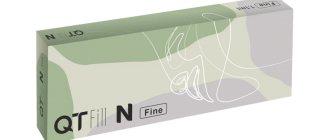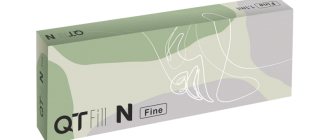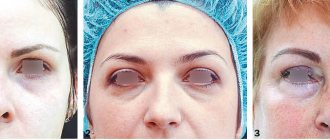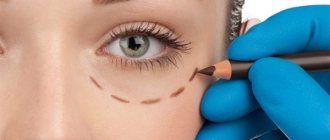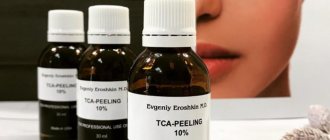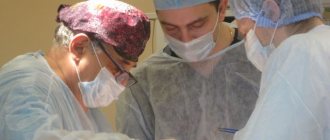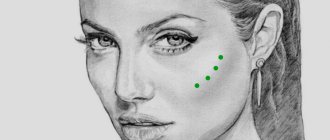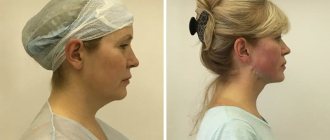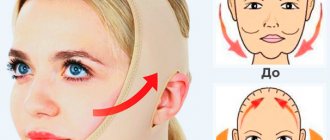Another non-surgical lifting method is a facelift with fillers. In this case, no special devices are required. Correction is carried out through drug injections.
In my opinion, the result of this procedure is somewhat worse than using other methods. But still, I want to talk about it so that you have a complete understanding of modern methods of facelift.
What are fillers?
Fillers are gels containing hyaluronic acid.
In the past, synthetic fillers were used. Unlike modern ones, they had a lot of contraindications and side effects.
These days, synthetic fillers have been abandoned. New fillers, the active component of which is hyaluronic acid, are safer and more effective. Their composition is considered safe. But in rare cases, allergic reactions are possible.
Hyaluronic acid is a component of human tissues: cartilaginous, connective, nervous, epithelial. During the aging process, the concentration of hyaluron in the body decreases. Because of this, the skin loses elasticity, wrinkles appear, and facial contours blur.
Fillers correct these changes. During the procedure, the gel is injected under the skin. It creates volume in the right places, stretching and lifting the skin.
In addition, the components of the gel stimulate the production of elastin and collagen.
The process of facelift using fillers is called bio-reinforcement using hyaluronic acid.
Contour plastic surgery of the lower third of the face
Is correction of the lower third of the face always solved separately, without affecting the middle third? For example, is it possible to remove marionette wrinkles, tighten the oval, leaving the nasolabial folds and cheekbones intact?
Everything is interconnected, and the doctor’s job is to take an integrated approach. Quite often I have to start with the correction of the middle third of the face. Because manifestations of ptosis in the middle third of the face will certainly provoke tissue drooping in the lower third. Primary correction of the cheekbones, temporal and infraorbital zones will significantly improve the situation and simplify the task: in the lower third we will have to work with a smaller volume of the drug. But there are times when, having competently worked on the middle third of the face, the need to correct the lower third simply disappears.
Please tell us what complex facial correction is, what areas does it involve working with?
Complex correction involves harmonizing the entire face. There are many nuances here, it all depends on what requests the patient came with. During the consultation, it immediately becomes clear to me the scope of work and which areas need contour correction. For one patient it is the entire face, for another it is some specific areas. Everything is very individual. Much depends on the volume of the chosen drug. The anatomical features of the patient's face are taken into account. My task is to correctly collect anamnesis, understand the patient’s wishes, give an appointment and carry out the procedure efficiently.
What drugs are the priority when working with volume replacement in the lower third and why?
As I said above, we work with three types of fillers. If we need to improve the quality of the skin, the choice will be in favor of a drug based on calcium hydroxyapatite or polylactic acid, we use them in dilution. If we need to replenish tissue volume, we will work with preparations based on hyaluronic acid of varying densities or a preparation with calcium hydroxyapatite, but in undiluted form. If we talk about the amount of filler injected, then a lot depends on the gender of the patient (men require more of the drug). Attention is drawn to the structure of the lower jaw and the presence of orthodontic problems. If the problems are minimal, we will need 1-2 ml, if significant, then 4-5 ml.
Why is botulinum therapy sometimes recommended to the patient when correcting the shape of the face or chin?
Botulinum toxin type A is often used to correct the entire face, in particular the lower third. When we see pronounced facial activity and muscle spasms: the chin is tucked in, the corners of the lips are pulled down. In such cases, we first “turn off” the depressor muscles using botulinum toxin, and then perform contour correction. This combination of techniques gives excellent results.
Why do some patients retain the effect after contouring for a long time, while others do not? What does this depend on?
It depends on the filler chosen. A drug based on hyaluronic acid “costs” from a year to a year and a half. True, there is one “but”: the human body produces an enzyme - hyaluronidase. If this enzyme is active, the hyaluronic acid filler will last less time. Consequently, such a patient will have to undergo contouring more often. As for the drug based on calcium hydroxyapatite, it remains in the tissues for up to 2 years.
What differences exist in correcting the lower third of the face in women and men?
There are differences, of course. To contour a man's face, a larger amount of the drug will be required. It is necessary to impart masculinity and brutality to the features, widen the angles of the lower jaw and the lateral part, and make the chin more square. We work with women's faces in smaller volumes, since the task is different - to make facial features more graceful and sophisticated.
Types of gels
There are three types of gel fillers.
- Synthetic
The active substances in them are: silicone, paraffin, polyacrylamide.
It is believed that these fillers provide a fairly long-lasting effect. And at the same time affordable.
However, a large number of contraindications and a high risk of complications negate the mentioned advantages.
Flaws:
- May begin to migrate under the skin
- Often cause allergies
- May provoke inflammatory processes
- They are not removed from the body (removal only by surgery).
- Biosynthetic
The composition of these gels is better compatible with facial tissues.
Main components:
- Collagen
- Carboxymethylcellulose
- Insoluble polymethyl methacrylate
- Hydroxyapatite
- Polycaprolactone.
Such fillers dissolve in 2-3 years, but do not require a second procedure.
Flaws:
- May cause swelling
- Blockage of blood vessels
- Necrosis
- Migration under the skin.
- Biodegradable
The safest fillers. Their components have a minimum of contraindications and are completely absorbed and excreted from the body.
The active component is hyaluronic acid.
Flaws:
- They can only occur due to incorrect administration of the gel.
First stage: correction of the angle of the lower jaw
The angle of the mandible is formed by the connection of the posterior border of the ramus and the lower edge of the body of the jaw. X-ray studies have shown that the average mandibular angle in women is 125 degrees, but this value varies even in aesthetically attractive patients.
The main goal when correcting the lower part of the face is to emphasize and make the patient’s natural mandibular angle more pronounced.
Technique
1. Determine volume loss in the preauricular space.
2. By palpation, find and mark the angle of the lower jaw.
3. Using a 23-gauge needle, create an entry point located superomedial (often at a distance of 0.5 cm) in relation to the mandibular angle.
4. Mark the future lower border and the posterior part of the body of the lower jaw (Fig. 1).
5. Use a 25-gauge (4 cm) cannula to aspirate to avoid intravascular injection of filler.
6. Using the linear-retrograde technique, inject filler (0.1 ml per line) in a volume of 0.5–1 ml in each direction.
7. Shape the product to achieve the ideal angular contour by gently palpating between the tips of two fingers.
Potential Risks
During correction of the posterior ramus of the mandible, the facial nerve and parotid gland are at risk because these two structures are located deep. You can avoid affecting them by injecting filler into the subdermal plane. When introducing the product into the lower edge of the maxillary branch, it must be remembered that the facial artery runs along the anterior edge of the masticatory muscle. It must first be palpated and excluded from the injection area.
Brief description: Purpose: to make the mandibular angle clearer.
Depth of injection: superficial/subdermal.
Volume: 0.5–1 ml per side.
Technique: cannula. Products of choice: Restylane Defyne, Restylane Volyme or Restylane Lyft
Second stage: contouring of the chin area (H3)
To determine the ideal proportions of the face, it is usually divided into three equal horizontal thirds and five vertical sectors (Fig. 2). Ideally, the chin occupies the central vertical sector.
Summary
I will be honest with you: I do not consider this correction method a worthy alternative to plastic surgery. As practice shows, fillers do not give the result that the patient would like to see. And the use of budget synthetic fillers even leads to the need for surgical intervention in some cases.
A facelift with fillers is suitable for targeted corrections of subtle age-related changes. When you just notice the first strokes and want to hide them immediately.
Pronounced age-related changes require more serious procedures. Here I would recommend surgical methods of correction. Because the devices also do not always cope with complex tasks.
To summarize the above, I would add that each case is unique. Therefore, a specialist can advise you on a suitable correction method only after a personal conversation. To choose the best one for you, we need to look, evaluate and take a history. Do not forget about this and do not make a decision about a particular procedure without a personal conversation with a specialist.
Fillers for contouring
For facial contouring, special filler preparations are used, which are injected under the skin. Due to the fact that they fill the subcutaneous layer in certain places, skin elasticity increases, wrinkles are smoothed out, and sagging is eliminated.
Our clinic uses only biodegradable preparations based on collagen, calcium hydroxyapatite and hyaluronic acid. This or that drug is selected by the doctor during an individual consultation, taking into account the wishes of the client and the nature of the problems being eliminated.
Removing jowls
By the age of 45-50, the aging process affects the lower part of the face, where the fat layer is located. It is poorly fixed by the muscle structure, so with age the tissues shift:
- Cheeks sag;
- The corners of the lips droop;
- The chin loses its shape.
You can remove jowls using contour plastic surgery of the chin and oval of the face. To avoid complications, before the procedure you should:
- Visit the dentist and check the correctness of the bite;
- Avoid drinking alcohol and visiting the bathhouse;
- Tell your doctor about the medications you are taking.
Injections are carried out with hyaluronic acid or calcium hydroxyapatite. Both drugs dissolve over time, so the procedure is repeated. Positive patient reviews of oval facial contouring indicate its popularity.
Despite the simplicity and safety of the technique, its result depends on the professionalism of the doctor.
During the rehabilitation period, the patient must refuse:
- From visiting the sauna, bathhouse and swimming pool;
- Being in direct sunlight;
- Solarium sessions;
- Facial massage;
- Physical activity.
The maximum effect of the injections appears after about a week and lasts from 4 months to 1.5 years.
The duration of the effect depends on a number of factors:
- Drug density;
- Amount of injected gel;
- Human lifestyle;
- Having bad habits;
- Age;
- Skin type;
- Metabolism;
- Injection techniques.
